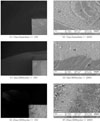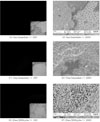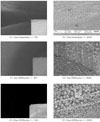Abstract
The purpose of this study was to evaluate the effect of different etching times on microtensile bond strength (µTBS) to dentin both initial and after thermocycling with 3 different types of total-etching adhesives.
Fifty four teeth were divided into 18 groups by etching times (5, 15, 25 sec), adhesives types (Scotchbond Multipurpose (SM), Single Bond (SB), One-Step (OS)), and number of thermocycling (0, 2,000 cycles).
Flat dentin surfaces were prepared on mid-coronal dentin of extracted third molars. After exposed fresh dentin surfaces were polished with 600-grit SiC papers, each specimen was acid-etched with 35% phosphoric acid (5, 15, 25 sec) and bonded with 3 different types of total etching adhesives respectively. Then, hybrid composite Z-250 was built up. Half of them were not thermocycled (control group) and the others were subjected to 2,000 thermocycle (experimental group). They were sectioned occluso-gingivally into 1.0 × 1.0 mm2 composite-dentin beams and tested with universal testing machine at a crosshead speed of 1.0 mm/min.
Within limited data of this study, the results were as follows
1. There was no statistically significant difference in µTBS between the thermocycled and non-thermocycled groups, except for both SM and SB etched for 25 sec.
2. In thermocycled SM and SB groups, bond strength decreased by extended etching time.
In total etching systems, adhesive durability for dentin could be affected by type of solvents in adhesive and etching time. Especially, extended etching time may cause deteriorate effects on bond strength when ethanol-based adhesive was used.
Figures and Tables
Figure 3
The microtensile bond strength before and after thermocycling by different etching time. A. Scotchbond Multipurpose (SM), B. Single Bond (SB), C. One Step (OS). Arrow indicates significant different (p < 0.05).

Figure 4
FE-SEM images of fractured surfaces after microtensile bond strength testing of SM.
B,D show mixed failure. F shows adhesive failure at the bottom of hybrid layer and resin tag are broken or left out of dentinal tubules (DT: dentinal tubule, C: composite resin, HL: hybrid layer, RT: resin tag)

Figure 5
FE-SEM images of fractured surfaces after microtensile bond strength testing of SB.
B,D show mixed failure. F shows adhesive failure at the bottom of hybrid layer and resin tag are broken or left out of dentinal tubules (HL: hybrid layer, DT: dentinal tubule)

References
1. Mjör IA, Moorhead JE, Dahl JE. Reasons for replacement of restorations in permanent teeth in general dental practice. Int Dent J. 2000. 50:361–366.

2. Titley K, Chernecky R, Maric B, Smith D. Penetration of a dentin bonding agent into dentin. Am J Dent. 1994. 7:190–194.
3. Van Meerbeek B, Inokoshi S, Braem M, Lambrechts P, Vanherle G. Morphological aspects of the resin-dentin interdiffusion zone with different dentin adhesive system. J Dent Res. 1992. 71:1530–1540.

4. Nakabayashi N, Nakamura M, Yasuda N. Hybrid layer as a dentin-bonding mechanism. J Esthet Dent. 1991. 3:133–138.

5. Gwinnett AJ. Chemically conditioned dentin: A comparison of conventional and environmental SEM finding. Dent Mater. 1994. 10:150–155.
6. Uno S, Finger WJ. Effects of acidic conditioners on dentine demineralization and dimension of hybrid layers. J Dent. 1996. 24:211–216.

7. Erickson RL. Surface interactions of dentin adhesive materials. Oper Dent. 1992. 5:81–94.
8. Pashley DH, Horner JA, Brewer PD. Interactions of conditioners on the dentin surface. Oper Dent. 1992. Suppl 5. 137–150.
9. Pashley DH. The effect of acid etching on the pulpodentin complex. Oper Dent. 1992. 17:229–242.
10. Inokoshi S, Hosoda H, Harnirattisai C, Shimada Y. Interfacial structure between dentin and seven dentin bonding systems revealed using argon ion beam etching. Oper Dent. 1993. 18:8–16.
11. Giannini M, Seixas CAM, Reis AF, Pimenta LAF. Six-month storage-time evaluation of one-bottle adhesive systems to dentin. J Esthet Restor Dent. 2003. 15:43–48.

12. Abu-Hanna A, Gordan VV. Evaluation of etching time on dentin bond strength using single bottle bonding systems. J Adhes Dent. 2004. 6:105–110.
13. Titley K, Chernecky R, Maric B, Valiquette N, Smith DC. The morphology of the demineralized layer in primed dentin. Am J Dent. 1994. 7:22–26.
14. Tay FR, Gwinnett JA, Wei SH. Relation between water content in acetone/alcohol-basd primer and interfacial ultrastructure. J Dent. 1998. 26:147–156.

15. Van Meerbeek B, Yoshida Y, Lambrechts P, Vanherle G, Duke ES, Eick JD, Robinson SJ. TEM study of two water-based adhesive systems bonded to dry and wet dentin. J Dent Res. 1998. 77:50–59.

16. Reis A, Loguercio AD, Azevedo CLN, Carvalho RM, Singer JM, Grande RHM. Moisture spectrum of demineralized dentin for different solvent-based adhesive system. J Adhes Dent. 2003. 5:183–192.
17. Carvalho RM, Mendonca JS, Santiago SL, Silveira RR, Garcia FCP, Tay FR, Pashley DH. Effects of HEMA/solvent combinations on bond strength to dentin. J Dent Res. 2003. 82:597–601.

18. Eick JD, Gwinnett AJ, Pashley DH, Robinson SJ. Current concepts on adhesion to dentin. Crit Rev Oral Biol Med. 1997. 8:306–335.

19. Sano H, Takatsu T, Ciucchi B, Horner JA, Matthews WG, Pashley DH. Nanoleakage: leakage within the hybrid layer. Oper Dent. 1995. 20:18–25.
20. Yoshida Y, Van Meerbeeek B, Nakayama Y, Snauwaert J, Hellemans L, Lambrechts P, Vanherle G, Wakasa K. Evidence of chemical bonding at biomaterial-hard tissue interfaces. J Dent Res. 2000. 79:709–714.

21. Van Meerbeek B, Vargas M, Inoue S, Yoshida Y, Peumans M, Lambrechts P, Vanherle G. Adhesives and cements to promote preservation dentistry. Oper Dent. 2001. 26:119–144.
22. Armstrong SR, Keller JC, Boyer DB. The influence of water storage and C-factor on the dentin-resin composite microtensile bond strength and debond pathway utilizing a filled and unfilled adhesive resin. Dent Mater. 2001. 17:268–276.

23. De Munck J, Van Meerbeek B, Yoshida Y, Inoue S, Vargas M, Suzuki K, Lanbrechts P, Vanherle G. Four year water degradation of total-etch adhesives bonded to dentin. J Dent Res. 2003. 82:136–140.

24. Hashimoto M, Ohno H, Sano H, Tay FR, Kaga M, Kudou Y, Oguchi H, Araki Y, Kuboda M. Micromorphological changes in resin-dentin bonds after 1 year water storage. J Biomed Mater Res. 2002. 63:306–311.

25. Sano H, Yoshikawa T, Pereira PNR, Kanemura N, Morigami M, Tagami J, Pashley DH. Long-term durability of dentin bonds made with a self etching primer, in vivo. J Dent Res. 1999. 78:906–911.

26. Hashimoto M, Ohno H, Kaga M, Kudo K, Sano H, Oguchi H. In vivo degradation of resin-dentin bonds in humans over 1 to 3 years. J Dent Res. 2000. 79:1385–1391.

27. Koshiro K, Inoue S, Tanaka T, Koase K, Fujita M, Hashimoto M, Sano H. In vivo degradation of resin-dentin bonds produced by a self-etch vs. a total etch adhesive system. Eur J Oral Sci. 2004. 112:368–375.

28. Gale MS, Darvell BW. Thermal cycling procedure for laboratory testing of dental restorations. J Dent. 1999. 27:89–99.

29. Kubo S, Yokota H, Sata Y, Hayashi Y. Microleakage of self-etching primers after thermal and flexural load cycling. Am J Dent. 2001. 14:163–169.
30. Cardoso PE, Placido E, Moura SK. Microleakage of four simplified adhesive systems under thermal and mechanical stresses. Am J Dent. 2002. 15:164–168.
31. Frankenberger R, Kramer N, Petschelt A. Long-term effect of dentin primers on enamel bong strength and marginal adaptation. Oper Dent. 2000. 25:11–19.
32. Gwinnett AJ, Yu S. Effect of long-term water storage on dentin bonding. Am J Dent. 1995. 8:109–111.
33. Hashimoto M, Ohno H, Sano H, Kaga M, Oguchi H. In vitro degradation of resin-dentin bonds analyzed by microtensile bond test, scanning and transmission electron microscopy. Biomaterials. 2003. 24:3795–3803.

34. Camps J, Pashely DH. Buffering action of human dentin in vitro. J Adhes Dent. 2000. 2:39–50.
35. Kinney JH, Balooch M, Hauot DI Jr, Marshall SJ, Marshall GW Jr. Mineral distribution and dimensional changes in human dentin during demineralization. J Dent Res. 1995. 74:1179–1184.

36. Abu-Hanna A, Gordan VV. Evaluation of etching time on dentin bond strength using single bottle bonding systems. J Adhes Dent. 2004. 6:105–110.
37. Nunes MF, Swift EJ Jr, Perdigao J. Effects of demineralization depth on microtensile bond strength to human dentin. J Adhes Dent. 2001. 3:137–143.
38. Kanca J. Effects of resin primer solvents and surface wetness on resin composite bond strengths to dentin. Am J Dent. 1992. 5:213–215.
39. Reis A, Loguercio AD, Carvalho RM, Grande RH. Durability of resin dentin interfaces: effects of surface moisture and adhesive solvent component. Dent Mater. 2004. 20:669–676.





 PDF
PDF ePub
ePub Citation
Citation Print
Print







 XML Download
XML Download